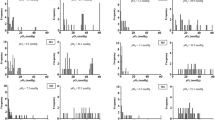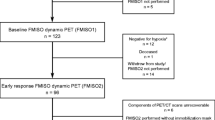Background and Purpose:
The aim of the present study was to validate ([18F] fluoromisonidazole (FMISO) and [18F]-2-fluoro-2’-deoxyglucose (FDG) positron emission tomography (PET) for determination of radiotherapeutically relevant hypoxia by the gold standard for measuring tissue oxygenation in human tumors, the computerized polarographic needle electrode system (pO2 histography).
Patients and Methods:
Up to now, a total of 16 patients with a metastatic neck lymph node from a primary squamous carcinoma of the head and neck underwent pO2 and PET measurements. Tumor tissue pO2 was measured with polarographic needle electrodes using a pO2 histograph (Eppendorf®). Under CT control, the needle electrode was placed in the tumor without general or local anesthesia. To assess the biological and clinical relevance of oxygenation measurement, the relative frequency of pO2 readings, with values ≤ 2.5, ≤ 5.0, and ≤ 10.0 mmHg, as well as mean and median pO2 were recorded.
All PET studies were carried out using an ECAT EXACT 922/47® scanner with an axial field of view of 16.2 cm. FMISO PET consisted of one static scan of the relevant region, performed 120 min after intravenous administration. The acquisition and reconstruction parameters were as follows: 15-min emission scanning and 4-min transmission scanning with 68Ge rod sources. FDG PET of the lymph node metastasis was performed 68 ± 11 min after intravenous administration, applying the whole-body tool with 8-min emission scanning and 4-min transmission scanning per bed position.
Results:
In order to detect possible relations between the different relevant polarographically measured parameters of tumor hypoxia and FMISO PET data-based oxygenation values, the Pearson correlation coefficient was calculated. Average (r > 0.5) to high correlation (r > 0.7) was found between tumor-to-muscle ratio of FMISO after 2 h and parameters of hypoxic fraction (pO2 readings with values ≤ 2.5, ≤ 5.0, and ≤ 10.0 mmHg as well as mean and median). No correlations could be shown between FDG PET parameters and polarographically determined tumor oxygenation status.
Conclusion:
Summarizing the FMISO uptake represents a global value for macroscopic tumor parts. As a noninvasive measurement this method seems highly feasible to evaluate the state of oxygenation in subjacent tumors.
Hintergrund und Ziel:
Ziel dieser Untersuchung war die Validierung von [18F]-Fluormisonidazol-(FMISO-) und [18F]-Fluordeoxyglucose-( FDG-)Positronenemissionstomographie (PET) zur Erfassung der strahlentherapeutisch relevanten Hypoxie durch das computergestützte polarographische Nadelelektrodensystem (pO2-Histographie), das den Goldstandard zur Festlegung der Gewebeoxygenierung in menschlichen Tumoren darstellt.
Patienten und Methodik:
Bis jetzt wurden bei insgesamt 16 Patienten mit metastatisch befallenen Halslymphknoten eines Plattenepithelkarzinoms der Kopf-Hals-Region pO2- und PET-Messungen durchgeführt. Der pO2 des Tumorgewebes wurde mit Hilfe polarographischer Feinnadelelektroden eines pO2-Histographen (Eppendorf®) gemessen. Die Nadelelektrode wurde CT-gesteuert ohne Lokalanästhesie positioniert. Als Grad für die biologische und klinische Relevanz wurden die relative Häufigkeit der pO2-Messwerte ≤ 2,5, ≤ 5,0 und ≤ 10,0 mmHg sowie der Mittelwert und der Median dokumentiert.
Die PET-Untersuchungen wurden an einem Vollring-Tomographen (ECAT EXACT 922/47®; Siemens/CTI) durchgeführt. Die FMISO-PET erfolgte als statische Aufnahme der relevanten Region 120 min p.i. Folgende Akquisitions- und Rekonstruktionsparameter wurden verwendet: 15-minütige Emissionsmessung und 4-minütige Transmissionsmessung mit Hilfe von 68Ge-Stabquellen. Die FDG-PET der metastatisch befallenen Halslymphknoten wurde 68 ± 11 min p.i. unter Verwendung eines Ganzkörperprotokolls mit einer Emissionsmessung von 8 min und einer Transmissionsmessung von 4 min pro Bettposition durchgeführt.
Ergebnisse:
Um mögliche Korrelationen zwischen den verschiedenen relevanten, polarographisch gemessenen Parametern der Tumorhypoxie und den mittels FMISO-PET gewonnenen Messdaten zu detektieren, wurde der Pearson-Korrelationskoeffizient berechnet. Es zeigte sich eine mittlere (r > 0,5) bis hohe Korrelation (r > 0,7) zwischen dem Tumor/Muskel-Quotienten der FMISO-Aufnahme 2 h p. i. und den verschiedenen Hypoxieparametern (pO2-Messwerte ≤ 2,5, ≤ 5,0, ≤ 10,0 mmHg sowie Mittelwert und Median der pO2-Messwerte). Keine Korrelation konnte zwischen den FDG-PET-Parametern und dem polarographisch bestimmten Tumoroxygenierungsstatus aufgezeigt werden.
Schlussfolgerung:
Die mit PET gemessene FMISO-Aufnahme gibt einen globalisierten Messwert für makroskopische Anteile des Tumors wieder. Aufgrund des nichtinvasiven Charakters scheint diese Methode besonders geeignet, den Oxygenierungsstatus bei tiefer liegenden Tumoren zu erfassen.
Similar content being viewed by others
Author information
Authors and Affiliations
Corresponding author
Rights and permissions
About this article
Cite this article
Gagel, B., Reinartz, P., DiMartino, E. et al. pO2 Polarography Versus Positron Emission Tomography ([18F] Fluoromisonidazole, [18F]-2-Fluoro-2’-Deoxyglucose). Strahlenther Onkol 180, 616–622 (2004). https://doi.org/10.1007/s00066-004-1229-y
Received:
Accepted:
Issue Date:
DOI: https://doi.org/10.1007/s00066-004-1229-y




